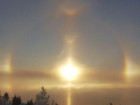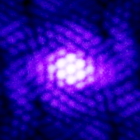|
Black Holes and Relativity Discussion
|
|
| midtskogen | Date: Sunday, 12.06.2016, 07:36 | Message # 1 |
 Star Engineer
Group: Users
 Norway
Norway
Messages: 1674
Status: Offline
| A black hole is said to have zero volume and infinite density, or is the standard definition of a black hole the shape spanned by the event horizon and the zero volume bit is the singularity within it?
What is the radius of a black hole anyway? If space is extremely bent inside the event horizon, the distance to the centre becomes enormous... Or for that matter how do you measure the distance to the event horizon from the outside, if you stand still or if you accelerate towards it? Relativity is confusing...
NIL DIFFICILE VOLENTI

|
| |
| |
| JackDole | Date: Sunday, 12.06.2016, 08:31 | Message # 2 |
 Star Engineer
Group: Local Moderators
 Germany
Germany
Messages: 1742
Status: Offline
| Quote midtskogen (  ) What is the radius of a black hole anyway?
If I have this understood correctly:
Since an object can never reach the center, even if it would not be destroyed, one might say, the radius of a black hole is actually infinite. 
Don't forget to look here.

|
| |
| |
| Watsisname | Date: Sunday, 12.06.2016, 09:02 | Message # 3 |
 Galaxy Architect
Group: Global Moderators
 United States
United States
Messages: 2613
Status: Offline
| Ahh, relativity... 
"Zero volume and infinite density" describes the singularity, or the resulting mass distribution after it has fully collapsed, in coordinates participating with the collapse (the observer who falls in), as calculated with classical general relativity. This description is popular, but sloppy. We have no idea what actually happens to the mass distribution under such conditions. Just that it becomes very small and dense, and then weird things happen beyond our current knowledge of physics. We also don't actually use that description for the singularity when we want to be rigorous. In general relativity, a singularity is a point where the curvature of the space-time geometry itself becomes infinite, and geodesics terminate. There need not be any reference to the matter at all.
This idea leads to one of my favorite descriptions of a black hole by Kip Thorne -- black holes are not made of matter. They are made of warped space-time. Whatever matter falls into them simply becomes the mass of the black hole, and that mass is manifest as space-time curvature.
Then there is the description in coordinates tied to an external observer. There, everything that ever fell into the hole exists in thin shells asymptotically approaching the horizon, and there is no interior at all. Space ends at the horizon! Weird, right?
Generally, astrophysicists and black hole researchers refer to a black hole's shape by its horizon. This is because it is an invariant object -- all observers agree on exactly where it lies. That, and the horizon is a very meaningful boundary. It literally separates events that happen inside the hole from the outside universe.
Where does it lie? This is at r=2GM/c2. This is in Schwarzschild coordinates, tied to the asymptotically flat external geometry.
How would you measure your distance to it from the outside? Well, you can't reach down to it with a ruler (the ruler would very soon cease to be a ruler), but you can use a variety of observations to determine what your distance is in units of Schwarzschild radii. Things like your orbit, time dilation / redshift of signals, deviation of nearby test masses, lensing of the light and apparent size of the black hole shadow, etc.
Of course, the space and time near and inside the black hole is incredibly distorted. The circumference of the event horizon is not equal to 2*pi*(Schwarzschild radius). It's less! The Schwarzschild radius is also not equal to the length of a rigid ruler spanning between the horizon and the singularity. No such ruler exists, and there is no unique answer. The physical distance from the horizon to the singularity depends on your definition of time coordinate! An observer falling into the hole cannot even say when they hit the singularity -- there is no invariant meaning to "when". The only meaningful measurement is the proper time -- how much time elapses on their clock.
Finally, to make things even less comfortable, a fun question is to ask how you would maximize the amount of time you have left before hitting the singularity, from the moment you fall through the event horizon. Would you accelerate upwards (away from singularity)? To the side? Towards it? 

|
| |
| |
| midtskogen | Date: Sunday, 12.06.2016, 09:40 | Message # 4 |
 Star Engineer
Group: Users
 Norway
Norway
Messages: 1674
Status: Offline
| If you throw something towards a black hole from a safe distance, you'll not see it fall through the event horizon either, so you might from that conclude that the event horizon is infinitely far away.
Normally, a shape is a specific description of the space that an object occupies. With black holes it's a bit the other way around. A black hole is a specific description of the shape of space.
EDIT: Watsisname, precisely. If black holes are not made of matter, they really don't have a shape either. What we observe is not a shape of an object, but the shape of space and time.
NIL DIFFICILE VOLENTI

Edited by midtskogen - Sunday, 12.06.2016, 09:48 |
| |
| |
| JackDole | Date: Sunday, 12.06.2016, 09:44 | Message # 5 |
 Star Engineer
Group: Local Moderators
 Germany
Germany
Messages: 1742
Status: Offline
| Quote Watsisname (  ) Kip Thorne -- black holes are not made of matter. They are made of warped space-time.
Basically, I agree with that. But ...
I'm not saying that I understand this correctly:
But according to the theory of loop quantum gravity, matter would not be zero, in a black hole. A 'quantum' rest would remain!
[Since this is off topic, maybe you can move it to a more appropriate thread?)
Don't forget to look here.

|
| |
| |
| Watsisname | Date: Sunday, 12.06.2016, 10:32 | Message # 6 |
 Galaxy Architect
Group: Global Moderators
 United States
United States
Messages: 2613
Status: Offline
| Quote midtskogen (  ) If you throw something towards a black hole from a safe distance, you'll not see it fall through the event horizon either, so you might from that conclude that the event horizon is infinitely far away.
Yep! This is a consequence of the Schwarzschild coordinates. These coordinates are very unhappy near the horizon. All physics at the horizon takes place at t=+∞ for the external observer.
However, we don't have to stick with Schwarzschild coordinates to analyze the hole. We can choose coordinates that are better behaved, like ingoing Eddington-Finkelstein coordinates. Then the finite nature of the path through the horizon and to the singularity becomes very clear.
Quote midtskogen (  ) If black holes are not made of matter, they really don't have a shape either. What we observe is not a shape of an object, but the shape of space and time.
Yeah, it is the geometry of the Schwarzschild space-time that has spherical symmetry. Basically by definition. But I don't really see how an object must be made of matter in order to "have a shape". Shape itself is of a mathematical nature, independent of matter, or indeed anything in the physical world. We may ascribe the shape to distributions of matter -- "objects" -- that we see in the physical world, saying that the object approximates the shape. But I think this applies just as well even without matter. I would say black hole event horizons approximate spheres.
JackDole: Yes, there are quantum-gravitational theories for the nature of the singularity. I'm not too knowledgeable on them though, and I don't think we have much confidence on a single description with experimental support. Quantum gravitation is still very much an area of active research. 
By the way, the solution to the question
"How you would maximize the amount of time you have left before hitting the singularity, from the moment you fall through the event horizon?"
...is to not accelerate at all. Freefall gives you the longest proper time. Any other action will only make your journey to the singularity end sooner!

|
| |
| |
| midtskogen | Date: Sunday, 12.06.2016, 10:48 | Message # 7 |
 Star Engineer
Group: Users
 Norway
Norway
Messages: 1674
Status: Offline
| Quote Watsisname (  ) I would say black hole event horizons approximate spheres.
In what coordinate system?
NIL DIFFICILE VOLENTI

|
| |
| |
| JackDole | Date: Sunday, 12.06.2016, 11:35 | Message # 8 |
 Star Engineer
Group: Local Moderators
 Germany
Germany
Messages: 1742
Status: Offline
| Watsisname,
I bet on the 'loop quantum gravity'.
Because, as far as I understand it, the 'loop quantum gravity' coincide with some of my ideas, at least partially, 
I have always believed that gravity also would have to be quantized, if the quantum theory is correct.
That is, if two objects are always moved further apart, there must come a time that gravity can no longer continue to decrease because she has achieved quantum size.
So they must totally cease to exist between these two objects!
I explain so the growing rate of expansion of the space between galaxies which are very distant from each other! 
I do not like the dark energy! 
Don't forget to look here.

Edited by JackDole - Sunday, 12.06.2016, 11:37 |
| |
| |
| Watsisname | Date: Sunday, 12.06.2016, 12:36 | Message # 9 |
 Galaxy Architect
Group: Global Moderators
 United States
United States
Messages: 2613
Status: Offline
| Quote midtskogen (  ) In what coordinate system?
In any coordinate system for which a non-rotating star also approximates a sphere. 
Don't be misguided by the idea of using coordinate systems to describe shape. That's not what they are for. That's not what they do. A shape is a geometric object that exists without coordinates. A coordinate system is something you slap onto the geometry to do math with it. Not all coordinate systems are equally useful or well behaved for a given application. It is the geometry that is fundamental. That's what the calculus of tensors is for.
The geometry of the event horizon is a null surface in space-time. It has spherical symmetry in 3D space, as it must for a spherically-symmetric source. (And even the collapse of a non-spherically symmetric distribution ends up producing a spherically symmetric field. Black hole event horizons obtain their symmetry very fast.)
You could pick a reference frame for an observer moving by a sphere at near the speed of light, and they would tell you the sphere is squished into a disk (which it is, though to the observer it would still be seen as a sphere -- just rotated). But that's just a Lorentz transformation from the coordinates in the sphere's frame.

|
| |
| |
| Watsisname | Date: Sunday, 12.06.2016, 12:55 | Message # 10 |
 Galaxy Architect
Group: Global Moderators
 United States
United States
Messages: 2613
Status: Offline
| JackDole, a gravitational force law which has a cutoff or stops decreasing for some r does not predict accelerating expansion. An attractive force will always produce a negative term in the second Friedmann equation. You need something that produces a positive term. That's what dark energy, or cosmological constant does. 

|
| |
| |
| JackDole | Date: Sunday, 12.06.2016, 14:02 | Message # 11 |
 Star Engineer
Group: Local Moderators
 Germany
Germany
Messages: 1742
Status: Offline
| Quote Watsisname (  ) You need something that produces a positive term.
Indeed?
I think water-filled buckets are very popular in the physics. 
Suppose I swing a bucket filled with water on a rubber band around me.
The rubber band is the gravitation. As long as I swing, the band expands ever further.
The universe is expanding.
Would I stop, would 'gravitation' pull back the bucket.
The universe would contract
But still I swing, the universe expanded ...
What happens when the rubber band snaps?
Or better, the band consists of many strands, just from the forces of different gravitational sources.
But some strands tear!
So, because I'm not a physicist, I would suspect, the remainder of the rubber band, expands faster!
(The water is not necessary! Could also be sand.)
Don't forget to look here.

Edited by JackDole - Sunday, 12.06.2016, 14:04 |
| |
| |
| midtskogen | Date: Sunday, 12.06.2016, 14:25 | Message # 12 |
 Star Engineer
Group: Users
 Norway
Norway
Messages: 1674
Status: Offline
| Quote Watsisname (  ) Don't be misguided by the idea of using coordinate systems to describe shape. That's not what they are for. That's not what they do. A shape is a geometric object that exists without coordinates. A coordinate system is something you slap onto the geometry to do math with it.
A geometric shape is defined by maths. An object could be a line in one coordinate system and a circle in another. A sphere has some mathematical properties. Like, if you know the surface area of a sphere, then you can calculate its volume, but do black holes have that property?
NIL DIFFICILE VOLENTI

|
| |
| |
| Watsisname | Date: Sunday, 12.06.2016, 22:16 | Message # 13 |
 Galaxy Architect
Group: Global Moderators
 United States
United States
Messages: 2613
Status: Offline
| Quote JackDole (  ) Indeed?
Indeed.
Quote JackDole (  ) Suppose I swing a bucket filled with water on a rubber band around me.
The rubber band is the gravitation. As long as I swing, the band expands ever further.
I should certainly hope not! The tension in the band is some function of its length. If the bucket is in uniform circular motion, then the tension force is constant, and so is the length. If the length is increasing, then either the angular frequency is increasing, or the rubber band is ceasing to be a rubber band.
This situation is not a good analogy for the physics of cosmological expansion. The expansion does not require an outward force, or a decrease in the inward force. The size of the universe is not due to a balance between inward and outward forces.
If you want an intuitive analogy for it, the closest one is the motion of a projectile launched upward from a gravitating mass. Radial velocity is analogous to expansion rate. Gravity is analogous to gravity. A trajectory that falls back is analogous to a closed universe, which expands to finite size and then collapses. Escape speed is analogous to a flat universe where the expansion rate slows to zero in infinite time.
Use the Friedmann equations. If you like, I'll derive them in a Newtonian context for you in a future post. It's a fun derivation. 
Midtskogen:
Geometry exists independent of coordinate systems. Coordinate systems are an analytical tool. The moment you choose a specific coordinate system, you are doomed, because your solution will depend as much on your choice of coordinates as it does on the geometry of the problem. This is what tensor calculus was made for.
Quote midtskogen (  ) Like, if you know the surface area of a sphere, then you can calculate its volume
Spheres are not defined by this property. Relationship between a sphere's surface area and enclosed volume depends on the geometry of the space. In space-time, result of the surface area calculation is invariant. Result of the volume calculation is not.

|
| |
| |
| midtskogen | Date: Monday, 13.06.2016, 05:41 | Message # 14 |
 Star Engineer
Group: Users
 Norway
Norway
Messages: 1674
Status: Offline
| Quote Watsisname (  ) In space-time, result of the surface area calculation is invariant. Result of the volume calculation is not.
Right. Care must be taken how a sphere is defined. I think the usual definition is that a sphere is made up of all the points that are equally distant from a single point, the centre of the sphere. I think that works out invariant of the coordinate system, but the radiant and centre aren't invariant. The simplest analogy is the 2D circle. On a globe the equator forms a circle, but the area of that circle depends on the coordinate system and so does the radius. If you expect A=πr² to work, you'll be using a 3D coordinate system putting the circle centre point in the same place of the globe's centre point, and the radius equals the globe's radius. But then the area isn't on the surface of the globe. If you want that, the area becomes twice as big.
If space-time within the event horizon of a black hole is bent to infinity, then I guess the space-time volume must be infinite as well and the space-time centre infinitely distant, but the surface area isn't. Which sounds odd, but using the circle on a globe analogy, we see that we don't use the pole to calculate the circle's circumference, but the globe's centre point.
Does it sound right?
NIL DIFFICILE VOLENTI

Edited by midtskogen - Monday, 13.06.2016, 05:53 |
| |
| |
| expando | Date: Monday, 13.06.2016, 09:47 | Message # 15 |
 Space Pilot
Group: Users
 Australia
Australia
Messages: 87
Status: Offline
| People say that once you enter the event horizon you can not escape, I'm not sure is true. With Hawking Radiation once you enter the event horizon or possibly even before it, time would reach infinity and then the black hole and event horizon will shrink instantly (from the travellers perspective) and then explode in a supernova. If you entered the event horizon near the speed of light in a hyperbolic orbit that just skims the event horizon, you can enter it and possibility escape the supernova.
"Religion is regarded by the common people as true - by the wise as false - and by the rulers as useful."
Lucius Annaeus Seneca
|
| |
| |